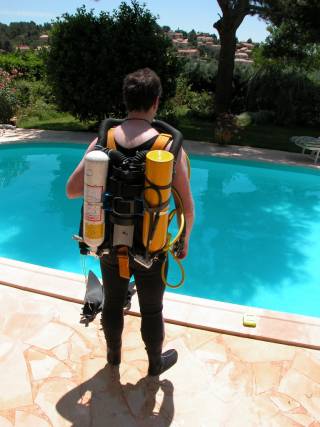 In
between drinking, eating, silliness and escaped panthers during the June
Port Miou expedition, we also managed to accumulate a great number of rebreathers
which I managed to have a go on. First of all, the great BQX. Here is a
back view of me wearing it. The white cylinder is the O2 bottle, the yellow
cylinder is the diluent. O2 is added using a Swagelok metering valve at
0.8l/min, KISS style. For simplicity I used it in O2 mode in the pool,
running it manually. In
between drinking, eating, silliness and escaped panthers during the June
Port Miou expedition, we also managed to accumulate a great number of rebreathers
which I managed to have a go on. First of all, the great BQX. Here is a
back view of me wearing it. The white cylinder is the O2 bottle, the yellow
cylinder is the diluent. O2 is added using a Swagelok metering valve at
0.8l/min, KISS style. For simplicity I used it in O2 mode in the pool,
running it manually. |
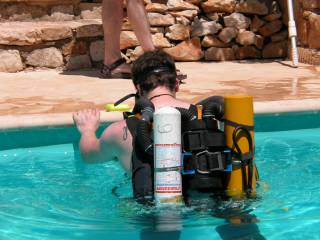
Here I am being too stubborn to admit how stupid an idea it was and actually getting into the pool and using it. Obviously, with five people looking on there was no way I was able to back out... peer pressure? Nah... |
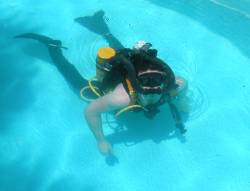 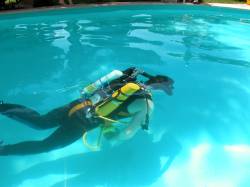 The
rebreather underwater. It has an extremely good breathing resistance in
the normal diving position. Hanging vertically it is not so good. Everything
worked very well, and I even managed to sink a toy submarine in the pool.
The custom made manual bypass O2 valve (a BCD inflator, a cable gland nd
some plumber's epoxy putty) has been one of the most succesful of my home
made parts. In fact it is the only home made part, the rest are off the
shelf components. The
rebreather underwater. It has an extremely good breathing resistance in
the normal diving position. Hanging vertically it is not so good. Everything
worked very well, and I even managed to sink a toy submarine in the pool.
The custom made manual bypass O2 valve (a BCD inflator, a cable gland nd
some plumber's epoxy putty) has been one of the most succesful of my home
made parts. In fact it is the only home made part, the rest are off the
shelf components. |
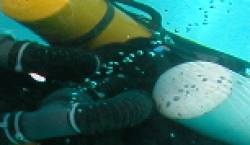 OK,
not everything worked perfectly. Bubble free diving with a rebreather?
Well, take a closer look... OK,
not everything worked perfectly. Bubble free diving with a rebreather?
Well, take a closer look... |
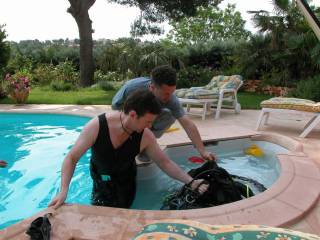 The
next unit I had a go on was Dr Jerome Meynie's Mk15.5 rebreather. This
shot illustrates how good jacuzzis are for washing dive equipment and getting
kitted up. The
next unit I had a go on was Dr Jerome Meynie's Mk15.5 rebreather. This
shot illustrates how good jacuzzis are for washing dive equipment and getting
kitted up. |
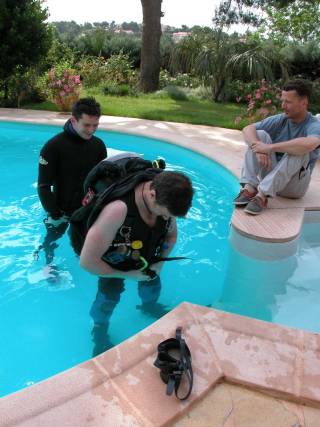 Putting
the unit on. It is an extremely well made, well thought out rebreather.
It has full electronic control of the ppo2, maintaining it at 1ATA. The
scrubber is a radial scrubber, capable of at least eight hours of diving.
Diluent and oxygen are contained in high pressure spheres within the rebreather
casing, there are manual bypass valves mounted either side of the case.
It has a heads-up primary display mounted adjacent to the DSV which uses
a series of LEDs to indicate whether the O2 is correct or not. For a more
exact reading there is a secondary display. This is an analogue meter with
a moving needle which reads the cell voltage directly and is calibrated
in ppO2 so there are no batteries to fail. The battery in the unit is only
there to drive the solenoid and control systems. The diluent being used
here is heliox 10 and with this simple unit that I am wearing I have the
capability of doing 5hrs at 100m Putting
the unit on. It is an extremely well made, well thought out rebreather.
It has full electronic control of the ppo2, maintaining it at 1ATA. The
scrubber is a radial scrubber, capable of at least eight hours of diving.
Diluent and oxygen are contained in high pressure spheres within the rebreather
casing, there are manual bypass valves mounted either side of the case.
It has a heads-up primary display mounted adjacent to the DSV which uses
a series of LEDs to indicate whether the O2 is correct or not. For a more
exact reading there is a secondary display. This is an analogue meter with
a moving needle which reads the cell voltage directly and is calibrated
in ppO2 so there are no batteries to fail. The battery in the unit is only
there to drive the solenoid and control systems. The diluent being used
here is heliox 10 and with this simple unit that I am wearing I have the
capability of doing 5hrs at 100m |
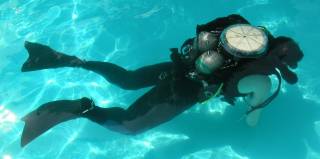 I
am diving the Mk15.5 without the back cover on so that we could spot any
leaks. The scrubber is the large circular casing at the top, there are
three sensors within it and the counterlung is underneath. The two balls
are the oxygen and diluent spheres. I
am diving the Mk15.5 without the back cover on so that we could spot any
leaks. The scrubber is the large circular casing at the top, there are
three sensors within it and the counterlung is underneath. The two balls
are the oxygen and diluent spheres. |
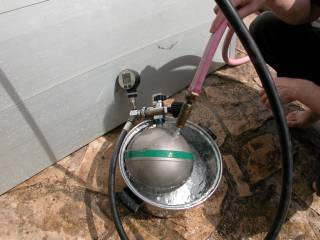 This
is the oxygen sphere being filled. And yes it is in a cooking pot. This
is the oxygen sphere being filled. And yes it is in a cooking pot. |
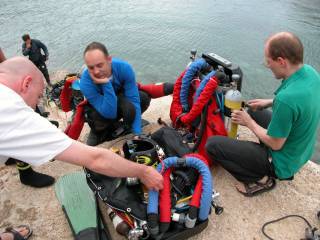 The
next unit I tried was the EDO-4, a Swiss passive semi-closed rebreather.
This is a very ingenious design. Active SCRs like the Draeger Dolphin add
gas continuously and at measured rate. These have many flaws, they have
no apparent failure modes, if something goes wrong then you can keep breathing
until you die. It is very easy to overbreathe the loop gas if the injection
system gets clogged with salt or if the diver breathes faster than gas
is being added to maintain loop ppO2. Passive SCRs a more cunning. They
only add gas when the diver breathes. If something fails then you know
about it because you cannot get a breath. Active SCRs have no sign that
they are functioning correctly, passive SCRs do. You can clearly hear and
feel gas being injected and hear gas being dumped. The
next unit I tried was the EDO-4, a Swiss passive semi-closed rebreather.
This is a very ingenious design. Active SCRs like the Draeger Dolphin add
gas continuously and at measured rate. These have many flaws, they have
no apparent failure modes, if something goes wrong then you can keep breathing
until you die. It is very easy to overbreathe the loop gas if the injection
system gets clogged with salt or if the diver breathes faster than gas
is being added to maintain loop ppO2. Passive SCRs a more cunning. They
only add gas when the diver breathes. If something fails then you know
about it because you cannot get a breath. Active SCRs have no sign that
they are functioning correctly, passive SCRs do. You can clearly hear and
feel gas being injected and hear gas being dumped. |
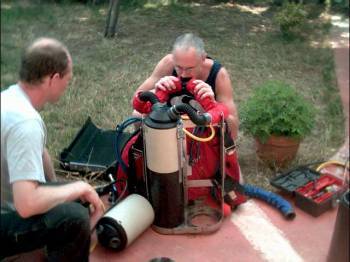 The
EDO-4 system uses a bellows instead of a counterlung. Every time the diver
exhales, a proportion of that gas is dumped overboard, around 10%. When
he then inhales it means that he cannot take a full breath and the bellows
bottoms out. When this happens it triggers an injector that fires enough
gas into the loop in order to make up a full breath. In this way the loop
gas is constantly refreshed and the makrs of another similar system, Halcyon,
say that the rebreather can actually function without any scrubber. If
anything fails then generally the diver will be aware of it because he
cannot get a breath. Normal operation is apparent because of the noise
of gas being dumped and the feel of gas being injected. The
EDO-4 system uses a bellows instead of a counterlung. Every time the diver
exhales, a proportion of that gas is dumped overboard, around 10%. When
he then inhales it means that he cannot take a full breath and the bellows
bottoms out. When this happens it triggers an injector that fires enough
gas into the loop in order to make up a full breath. In this way the loop
gas is constantly refreshed and the makrs of another similar system, Halcyon,
say that the rebreather can actually function without any scrubber. If
anything fails then generally the diver will be aware of it because he
cannot get a breath. Normal operation is apparent because of the noise
of gas being dumped and the feel of gas being injected. |
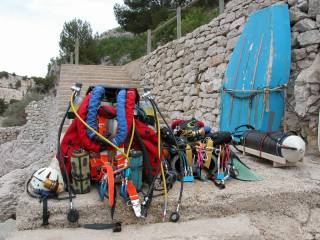 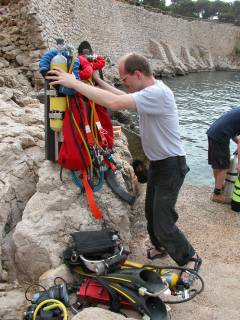 The
unit is very compact, about the size of a 12L cylinder. Unfortunately it
is not really suitable for open water use as it takes at least two diluent
switches to use it on dives deeper than 21m. It is also designed to be
used with fairly large bottles for bail-out. The Swiss configuration is
a double rebreather set-up with connections so that both rebreathers are
supplied with the same drive gas. There is no open-circuit bail-out option,
instead the diver dives the double rebreather set like an independant twinset,
15min on one rebreather and then switch to the other, 15min on that and
then switch back to the first one and so on. This makes the rebreather
quite bulky and difficult to handle out of the water; it is extremely heavy.
The photographs give an idea of its size and complexity. The
unit is very compact, about the size of a 12L cylinder. Unfortunately it
is not really suitable for open water use as it takes at least two diluent
switches to use it on dives deeper than 21m. It is also designed to be
used with fairly large bottles for bail-out. The Swiss configuration is
a double rebreather set-up with connections so that both rebreathers are
supplied with the same drive gas. There is no open-circuit bail-out option,
instead the diver dives the double rebreather set like an independant twinset,
15min on one rebreather and then switch to the other, 15min on that and
then switch back to the first one and so on. This makes the rebreather
quite bulky and difficult to handle out of the water; it is extremely heavy.
The photographs give an idea of its size and complexity. |
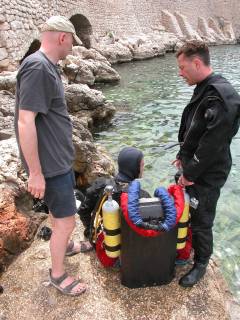 In
this shot I am preparing to dive on the double EDO-4 system. Breathing
it felt completely different from any of the other rebreathers which I
had used, feeling much closer to that of open-circuit. In a way, it is
very close to diving open circuit because for the end part of the inhalation,
the diver is effectively breathing from an open circuit regulator. In
this shot I am preparing to dive on the double EDO-4 system. Breathing
it felt completely different from any of the other rebreathers which I
had used, feeling much closer to that of open-circuit. In a way, it is
very close to diving open circuit because for the end part of the inhalation,
the diver is effectively breathing from an open circuit regulator.
The efficiency of the rebreather is a trade off between gas consumption and ppO2. By reducing the amount of gas dumped overboard the rebreather can become very efficient however the partial pressure of the loop will drop dramatically, perhaps even dangerously. To maintain a higher partial pressure then the amount of gas dumped must be increased and efficiency suffers. What some divers do is to run the unit on high O2 diluents: breathed in the loop the ppO2 will drop to an acceptable level whilst still keeping the rebreather efficiency but the drive gas cannot be breathed in open-circuit bail-out mode. Also, there is a fairly narrow depth range that a drive gas can be used over and on a dive where the depth is reasonably constant then it is not a problem. In caves where there is a big variation in depth then many gases must be used and the dive becomes difficult logistically. A fatality last year highlighted one of the most dangerous failure points on the rebreather and all the similar units. In the bellows is a small one-way valve which controls the dumping of gas. If this fails then no gas is dumped and the diver will continue to breathe until the loop ppO2 drops and he passes out because no fresh diluent is being added to the loop. To avoid this the diver has to be very aware of the sounds the unit makes, it makes a slight gurgle on each breath as gas is dumped. If the noise isn't there then there is a problem. Unfortunately when using scooters it is very difficult to actully hear this. Another indicator is the feel of gas being injected at the end of a breath but again this is not always apparent if not taking deep breaths. I would be very worried about using passive SCRs in a stressful environment and having to be aware of these indicators as well as everything else that is going on. For me, being able to look at a gauge is worth the risk of an extra failure point. Whilst diving on the EDO-4 I was continually listening for sounds and it is a hard rebreather system to relax on. |
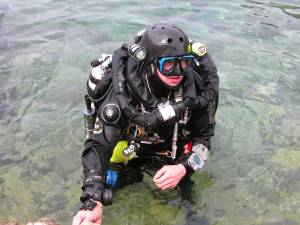 The
EDO-4 is not the only passive SCR on the market. In Germany there are the
RECY'01 and the Trilobyte units which both work on the same designs and
principles. In the US, Halcyon produce the RB80 which is also very similar.
Here Thomas Baum dives on a double German passive SCR set up. The EDO-4
uses a Draeger Ray DSV, Thomas has put Inspiration DSVs on his German versions. The
EDO-4 is not the only passive SCR on the market. In Germany there are the
RECY'01 and the Trilobyte units which both work on the same designs and
principles. In the US, Halcyon produce the RB80 which is also very similar.
Here Thomas Baum dives on a double German passive SCR set up. The EDO-4
uses a Draeger Ray DSV, Thomas has put Inspiration DSVs on his German versions. |